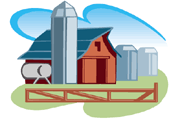Bulletin #2336, Maine Farm Safety Program: Roll-Over Protective Structures and Power Takeoff Shields

By Dawna L. Cyr, Farm Safety Project Assistant, and Steven B. Johnson, Ph.D., Extension Crops Specialist
For information about UMaine Extension programs and resources, visit extension.umaine.edu.
Find more of our publications and books at extension.umaine.edu/publications/.
Two major safety features on tractors are roll-over protective structures (ROPS) and power takeoff (PTO) shields. ROPS, when combined with seat belt use, offer effective protection in the event of tractor accidents and overturns. PTO shields help prevent injuries on the farm by protecting workers from moving parts. Leaving protective shields can help to reduce the number of injuries that occur and possibly save a life or limb. It is also the law.
Roll-Over Protective Structures
Do not add a ROPS to an older tractor if the manufacturer does not approve the use of the particular system. Look for equipment that meets performance criteria established by a recognized testing authority. A homemade ROPS is not recommended. ROPS are available as simple steel frames or quiet, dustproof cabs. A ROPS combined with a seat belt can save a life.
The ROPS cab is a very popular option due to its comfort, health and safety benefits. The cab provides weather protection and can be heated and air-conditioned. Filters remove dust and insects. The latest cabs are relatively quiet when the windows are closed. The ROPS cab protects the operator from low branches, flying parts, and from being sprayed by chemicals or hydraulic fluid if lines rupture.
- Consider adding an approved ROPS to an older tractor.
- Wear the seat belt provided when a ROPS is installed.
- Always make sure the PTO is disengaged before starting the tractor.
- Allow no one near a moving PTO or PTO-driven equipment if someone isn’t by the PTO disengage lever.
- Never operate a PTO without a shield covering the shaft and yoke.
Using a PTO
Keep the tractor and attachments in good operating condition and keep safety devices in place. Use guards as instructed in the operator’s manual. Be sure the power takeoff lever is in the off or disengaged position before starting an engine. Keep safety shields in place when using the power takeoff. Always keep sleeves, jackets or other items of clothing relatively tight and belted since they might be caught in the moving parts.
Always make sure the engine is off, the PTO clutch disengaged and the PTO shaft stopped before adjusting an implement hitch or power takeoff hook-up or cleaning out a PTO-driven implement. Disengage the PTO and shut off the engine before adjusting or unclogging power-driven machinery. Never start a PTO-driven machine if people are on or close to it.
Remove the PTO master shield only when necessary. Always install the PTO guard on the power takeoff when the PTO is not being used. When using the PTO, be sure all PTO shields are in place on both the tractor and implement.
PTO Shields
There are two types of PTO stub shaft shields commonly in use. (The stub shaft is the area where the PTO implement is attached to the tractor.) There is the master shield, which provides a zone of protection around the stub shaft, and the PTO stub shaft guard, which completely covers the stub shaft. If the PTO master shield must be removed for the installation of mounted implements, the stub shaft guard should always be in place. If a shield becomes damaged or lost, replace it as soon as possible. Turn off the engine and disengage the PTO drive before attempting to unplug or service machinery.
Using ROPS and PTO shields can help reduce injuries or their severity on the farm. With fewer injuries, production is increased leading to increased profits.
This Maine Farm Safety fact sheet is part of an educational fact sheet series produced by University of Maine Cooperative Extension. For more information on farm safety, contact your UMaine Extension County Office.
Information in this publication is provided purely for educational purposes. No responsibility is assumed for any problems associated with the use of products or services mentioned. No endorsement of products or companies is intended, nor is criticism of unnamed products or companies implied.
© 2003, 2020
Call 800.287.0274 (in Maine), or 207.581.3188, for information on publications and program offerings from University of Maine Cooperative Extension, or visit extension.umaine.edu.
In complying with the letter and spirit of applicable laws and pursuing its own goals of diversity, the University of Maine System does not discriminate on the grounds of race, color, religion, sex, sexual orientation, transgender status, gender, gender identity or expression, ethnicity, national origin, citizenship status, familial status, ancestry, age, disability physical or mental, genetic information, or veterans or military status in employment, education, and all other programs and activities. The University provides reasonable accommodations to qualified individuals with disabilities upon request. The following person has been designated to handle inquiries regarding non-discrimination policies: Director of Equal Opportunity and Title IX Services, 5713 Chadbourne Hall, Room 412, University of Maine, Orono, ME 04469-5713, 207.581.1226, TTY 711 (Maine Relay System).

